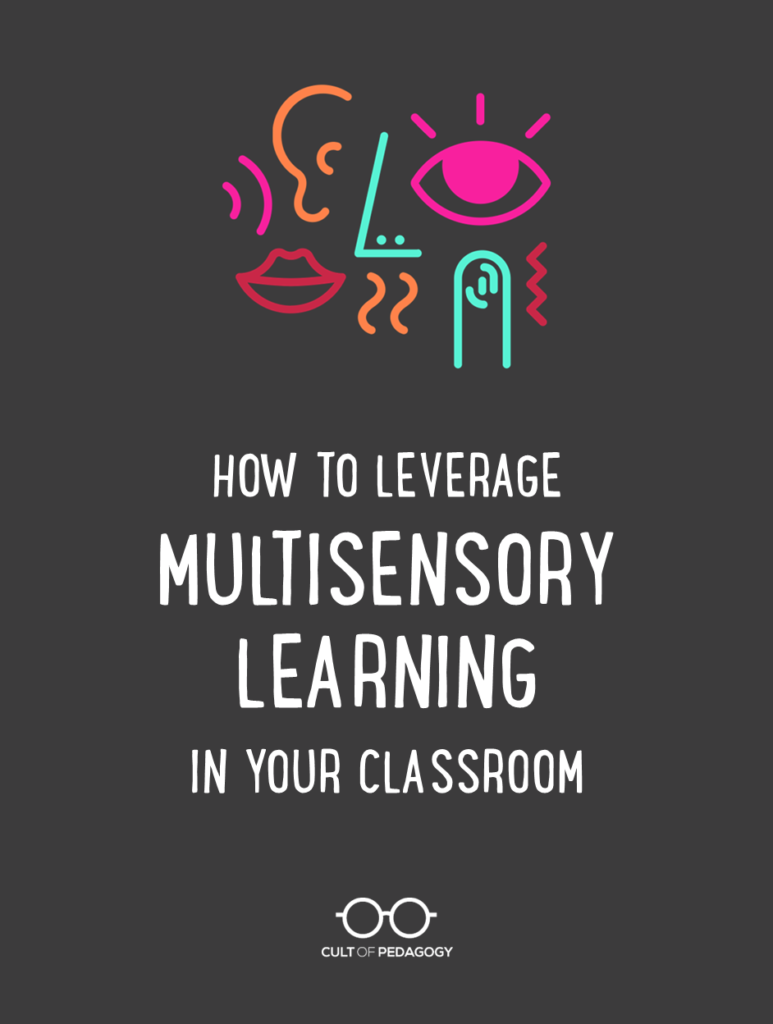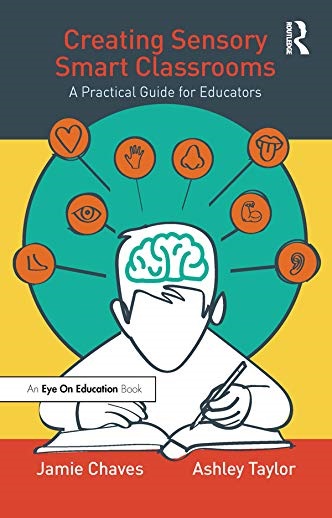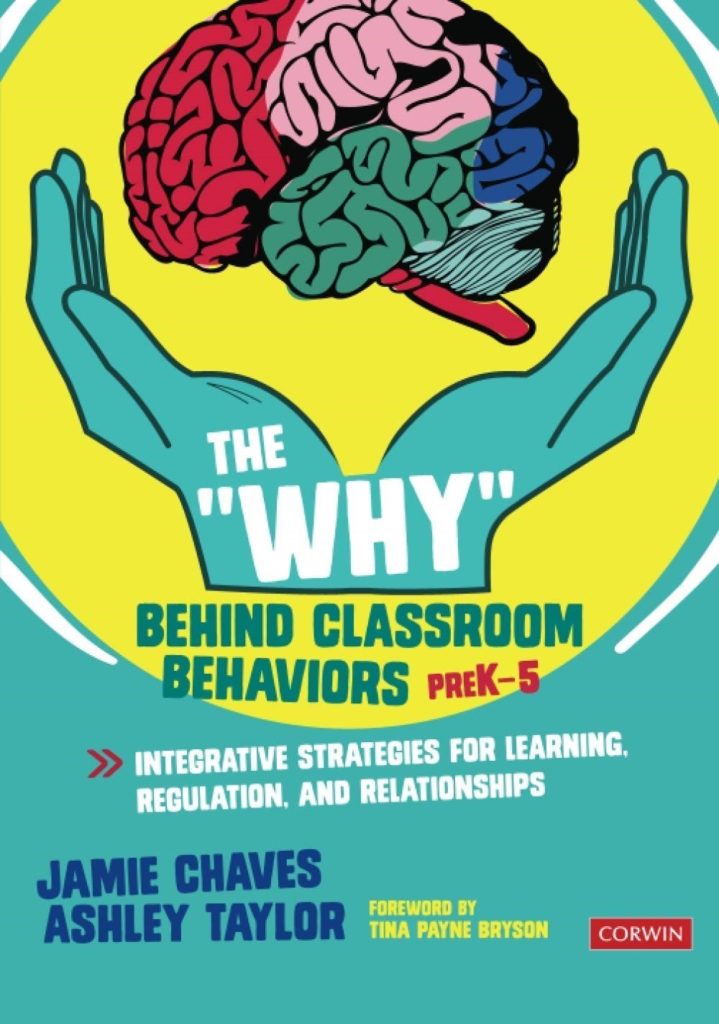
Listen to the interview with Jamie Chaves:
Sponsored by EVERFI and Today by Studyo
This page contains Amazon Affiliate and Bookshop.org links. When you make a purchase through these links, Cult of Pedagogy gets a small percentage of the sale at no extra cost to you. What’s the difference between Amazon and Bookshop.org?
“If it hasn’t been in the hands, it can’t be in the brain.” This is a quote I see every morning when I drop my daughter off at preschool. Even though she hasn’t studied sensory integration theory or neuroscience, my daughter’s teacher knows this from experience.
My biology teacher in high school embraced this idea as well. I remember more from his class than any other I’ve taken because he fully embraced multisensory learning — learning that integrates multiple senses at one time. We created diagrams of a cell body, acted out the different genetic combinations of Mendel’s pea plants, drew out and recited aloud the steps in the Krebs cycle, and used PTC paper to determine if we were a taster or non-taster.
The brain is an integration machine. Research shows that there’s a synergistic effect to multisensory learning: when more than one sense is accessed during a learning experience, learning is boosted, even from a very young age (Benstead, 2020). For example, when an infant sees and touches an object, the brain lights up significantly more than when the infant only sees the object. This is also true when the infant sees, touches, and hears an object compared to just seeing and touching the object. This highlights the importance of multisensory learning in order for the brain to make connections and integrate information. And if you’ve ever been around a toddler for more than 10 minutes you’ll experience this first hand — they want to move and touch and talk while they perform a task.
Sensory integration, in so many ways, sets the foundation for learning. The sensory systems must work in concert to facilitate things such as regulation, attention, sitting upright, writing, reading, organizing materials, and engaging socially, to name a few. When we engage students in multisensory learning we’re not only enhancing their learning experiences and brain integration; we’re also facilitating the development of these foundational skills. This is why things “being in the hand” is so important, particularly during the early stages of learning. Yes, when we hold a flower in our hands and smell it, we are learning about the softness of the petals, the sweetness of its smell, the delicateness of how it must be held. But we are also sustaining our attention, organizing our body movements, and sharing the experience with others much more than if we were simply looking at a picture of that flower in a book.
When we break down the sensory systems it is truly remarkable how they serve as the building blocks to regulation, engagement, exploration, safety, movement, social interaction, and brain integration. By applying some basic principles of sensory processing to your teaching, you’ll remove unnecessary barriers and boost learning in some pretty significant ways.


Getting Acquainted With Our 8 Sensory Systems
Many people have heard of the five external sensory systems: touch (tactile), sound (auditory), sight (visual), taste (gustatory), and smell (olfactory), but there are actually three more internal sensory systems that drive much of our behavior: vestibular, proprioceptive, and interoceptive. Once you know more about the breadth and depth of the sensory systems and how they impact students’ ability to learn and engage, you will have another lens through which to view behavior and ask questions to support all of your learners. Plus, you can start to use sensory information to your advantage at different points during the day, both for you and for your students.
- Auditory input is what we hear. This input helps us determine spatial awareness, engage socially, maintain attention, feel a sense of environmental safety, and sustain balance.
- Visual input is what we see. We use this information for environmental awareness, eye-hand coordination, balance, sense of safety, orientation in space, depth perception, and social engagement (like reading non-verbal cues).
- Tactile input is what we touch and feel. This sense allows us to build self-regulation; gain emotional security; manipulate objects; learn about texture, pain, and temperature; and establish body awareness.
- Gustatory input is what we taste. We use this information to know what is safe and desirable to eat and drink.
- Olfactory input is what we smell. We use it when we eat and drink, for environmental safety, and for emotion related to our memories.
- Proprioceptive input is how we perceive our body in space; it is, essentially, our body awareness. It helps us facilitate grading of force, hold and manipulate objects, build self-regulation, and navigate the environment (without bumping into things).
- Vestibular input is how we perceive our relationship to gravity and orientation in space. We use this information for balance, muscle tone, maintaining alertness and attention, motor coordination, sustaining an upright posture, and visual orientation.
- Interoceptive input is how we perceive our internal needs. We use this sense for emotional awareness, bodily needs, and sense of safety.
How the Subtypes of Sensory Processing Impact Learning
Along with the different sensory systems, there are a few different subtypes of sensory processing that can be considered in multisensory learning. Each of the eight sensory systems has two subtypes: sensory modulation and sensory discrimination. Then there is another subtype of sensory integration called sensory-based motor skills.
Sensory Modulation
Modulation is essentially the brain’s ability to dial up or down how much sensory input is received to prevent too little or too much stimulation. In the classroom students must filter out visual input on the walls to focus on what is being written on the board. They must also receive enough vestibular input in order to sit upright in the chair.
Sensory modulation is linked with our feeling of safety. When we perceive a particular sensory input as unsafe, this can trigger a flight-fight-or-freeze response via activation of the amygdala. Sirens are loud for a reason: they signal to our auditory system that something is wrong and we need to act.
What this means for teachers: Sensory modulation varies from student to student and from situation to situation. This will impact how they behave in school on a particular day or in a particular class. Factors such as sleep, diet, and life changes can impact sensory modulation because our nervous systems feel more stressed (consider how things seem louder, faster, brighter when we don’t get enough sleep!). When a student has a strong reaction to sensory input — for example, touching a slimy, wiggly worm in science class for the first time — co-regulation in a positive, safe relationship is often critical in calming that student’s nervous system. In our books, we define co-regulation as “attuned and responsive interactions between a child and adult that allow them to reach a state of regulation together” (Chaves & Taylor, 2020). A teacher’s calm presence, non-verbal cues, and verbal communication helps to facilitate co-regulation. This co-regulation is also protective in subsequent experiences that are similar so the nervous system learns not to be triggered by sensory inputs that are not necessarily unsafe. Think about how a teacher’s co-regulation while the student is touching the worm can make her feel calm and safe with each successive exposure: the teacher might relax his body, get down on the student’s level, smile at the student, and reflect how the worm might feel in order to co-regulate with the student.
It is important to note that students who are understimulated — that is, do not respond as readily to sensory input — are often overlooked because they don’t necessarily “act out” like overstimulated students. Students who take a long time to respond to their name, or need physical touch along with the verbal cue, may have difficulty “dialing up” the amount of auditory input needed. Or a student who wants to lie down on the carpet during circle time may have an understimulated vestibular system, causing him to not receive enough input to maintain an upright position. He may need to stimulate his vestibular system by jumping up and down several times before sitting on the rug to “wake up” his body. Not having enough sensory input to the brain can impact learning just as much as having too much!
Sensory Discrimination
Discrimination is how we differentiate the temporal (time) and spatial (space) properties of sensory input so we can make meaning out of it and use it to engage in meaningful activities. This is what we do with the input rather than how we react to the input.
For example, we might feel a spider crawling on our arm (sensory modulation) and we can tell where and how fast the spider is moving (sensory discrimination). Students use discrimination to hold a pencil and push down on the paper with the right amount of force. They discriminate where a sound is coming from when a peer calls their name out at recess. We also use discrimination to discern the difference between similar textures, sounds, sights, movements, internal needs (including emotions!), tastes, and smells. When a student reaches into the depths of her backpack to pull out a pencil, not a marker or crayon, she is discerning a difference in the textures. This can also help us anticipate the properties of sensory inputs such as knowing what a gymnasium is likely going to smell like versus what a cafeteria will smell like.
What this means for teachers: Students rely heavily on sensory discrimination to perform tasks with precision, and repeated exposure to a wide variety of sensations helps to enhance discrimination. Sensory discrimination requires our attention, and is more of a conscious process compared to modulation — differentiating the letter “b” from “d” is a higher-level cognitive demand compared with simply seeing there are letters on the paper. A student with sensory discrimination differences will require things to be presented in a variety of ways over the course of several instructional periods. Drawing on multiple senses, and doing activities with varying intensity, duration, and speed, will help bolster the discriminatory abilities of the targeted sensory input. If we keep with the letter “b” and “d” discrimination example, a student may need to not only see the letters but also form them with her body, write them in shaving cream, identify them in different fonts, use a mnemonic, trace them fast and slow, etc.
Sensory-based Motor Skills
Sensory-based motor skills are required for praxis (ideation, motor planning, sequencing, motor execution) and postural stability; this is the last identified subtype of sensory processing. Sensory-based motor skills combine tactile, vestibular, and proprioceptive information for motor output. These skills help us organize plans for an activity, coordinate movements, learn new movements, maintain an upright position, shift position accordingly, and effectively use oculo-motor skills. When a student must take out a book from his desk and turn to a certain page, he is using sensory-based motor skills.
These are the foundation for building strong executive function skills — organizing our bodies must come before organizing other aspects of life! As students learn to better manage the movements of their bodies, and do so in a smooth, coordinated manner, they will also better learn to manage their environment such as self-monitoring their learning and sequencing their ideas. Sensory-based motor skills allow for automaticity of movements that promote efficiency in navigating the world and free up more brain space for higher level cognitive tasks.
What this means for teachers: Students will have different degrees of sensory-based motor skills, so keep this in mind when observing their actions. Just think: as toddlers improve in their ability to walk, they can soon focus more on what they see or hear when they walk instead of simply staying upright. The same is true for students: those with strong sensory-based motor skills can listen to instructions while completing their work instead of stopping what they’re doing in order to solely focus on what the teacher is saying. Dyspraxia — a form of difficulty with sensory-based motor skills — can be quite frustrating for a student, often resulting in avoidance of a challenging activity, low self-esteem, and compensatory behaviors (such as doing things quickly to mask the inability to do something well, or acting silly as a means of self-deprecation). It is important to provide these students with considerable time and patience, especially when introducing a new activity; use backward chaining and scaffolding; and practice co-regulation to decrease the amount of performance anxiety they may feel.
Applying Multisensory Learning in the Classroom
Research consistently supports the use of multisensory learning in the classroom in order to enhance engagement, memory, and information retrieval (Shams & Seitz, 2008). Providing multisensory learning experiences not only facilitates increased brain integration, it also allows for increased participation from students who learn differently, particularly in the areas of reading and writing (Waterford, 2019 ). The National Reading Report indicates that only 35% of 4th graders and 34% of 8th graders across the nation scored at or above the proficient level in reading (National Assessment of Educational Progress, 2019). This suggests that the way traditional schools are teaching reading is not working. All students deserve instruction that meets their needs, and multisensory learning is a great place to start.
Now for the big question: how can I use multisensory input to my advantage in the classroom?
1. Weave In Sensory Inputs AND Sensory Subtypes
First, think about how you can combine 2-3 of the eight sensory systems during classroom instruction and classroom activities in order to enhance brain integration and cater to the learning needs of all students. This might look like:
- Playing hopscotch with letters to form spelling words
- Standing up when answering a question in class
- Rolling a ball back and forth with a partner to name prime numbers
- Dressing up as historic figures when learning about them
- Bringing in different leaves for students to pass around when teaching about trees
- Moving both arms in the air to indicate specific times on a clock
Secondarily, consider how the instruction or activity facilitates sensory modulation, sensory discrimination, or sensory-based motor skills. Some examples include:
- Allowing students to sit on a yoga ball chair, t-stool, or wiggle stool provides vestibular modulation that can enhance upright seated posture and attention.
- Writing on sandpaper, tissue paper, construction paper, and cardboard provides different surfaces for tactile and proprioceptive discrimination that can enhance writing efficiency.
- Setting up stations around the room for students to navigate to and sequence, such as making a map of different climate zones, helps students integrate sensory-based motor skills.
2. Honor Sensory Preferences When Possible
Have you ever noticed that too much light or clutter in a room makes it hard for you to focus? Or maybe you find yourself more engaged and alert when eating a crunchy snack? Sensory preferences are the inputs we lean into or minimize to help keep us regulated throughout the day; too much of non-preferred sensory input or not enough of a preferred sensory input can cause dysregulation, like poor concentration, irritability, frustration, or drowsiness. We all have sensory preferences, and the more we can adjust our learning environment to better fit student preferences, the better they will learn.
There are many ways you can track these preferences, including this one by How Does Your Engine Run? Alert Program. Along with learning your students’ preferences, knowing your own sensory preferences can help you identify why there are times of the day or particular students or certain activities that cause you to feel more regulated or dysregulated than others. This will allow you to better co-regulate with students, as well as not feel so drained by the end of the school day.
In our book, Creating Sensory Smart Classrooms, we provide a worksheet that you can use to help identify the sensory preferences of your students. Many of the questions are tailored from the adult checklist mentioned above. Once you know the sensory preferences of your students you can better assess which sensory inputs you should take out of your classroom because they’re too distracting or dysregulating, and which ones you should integrate more into your classroom because they’re attention-provoking and regulating. And when you notice yourself or one of your students behaving in a way that’s indicative of dysregulation, you can go back to this checklist to see if there may be some sensory input that’s contributing to that (because the input is too much or because it’s lacking).
3. Use Novelty with Intention
The brain responds readily to novel sensory stimuli, which can impact attention and regulation. By using multisensory inputs in the classroom the brain better learns what to pay attention to and what to filter out so that students can be more engaged in learning. When the brain first perceives sensory input, it must attend to that input, essentially to discern its importance: Should I focus more on this or not? Once a sensory input happens enough, the brain learns to habituate to that input so resources can go elsewhere (for example, we don’t think about the lights in a classroom each time we enter, we think about the conversations happening). However, when a new sensory input happens– when something changes in the otherwise familiar environment– the brain will now attend to that input to assess its safety and importance (when the lights turn off in the classroom we shift our attention away from the conversation to attend to the change in stimuli). This shift causes an increase in focus and attention to that new stimuli.
When students hear you talking in your typical tone and volume, then you shift to a whisper or a different accent, the brain says, “Hey, that’s different; I should pay attention!” Or, if your students typically write on regular paper, they might be more engaged by writing on textured paper or with textured pencils because the brain enjoys the novelty of the sensory experience. Alternatively, if your students seem to be distracted when you change what’s hanging on the walls each month, you might only change one or two things so they’re not so focused on the novelty.
4. Engineer the Environment with Sensory Inputs
Finally, there are certain sensory inputs across the board that tend to be more calming rather than stimulating. Most everyone can agree that sleeping with the lights off, lying down, and with soothing music is more conducive than sleeping with the lights on, standing up, and with heavy metal music. This is slightly different than sensory preferences, which are more tailored to each individual. In this way, you can manipulate the sensory environment of the classroom to engage more (or fewer) sensory systems when learning. Students may need different inputs at different times of day, depending on arousal level.
For example, turning off the lights and turning on calm music when returning back from lunch/recess can help reset the tone for engaging again in focused learning. Or they might need more movement-based learning experiences and alerting essential oils at the end of the day when their bodies and brains are becoming unfocused from fatigue. Be a scientist: play around with the sensory environment in your classroom and see what happens– then adjust accordingly after observing the responses of your students (and of yourself!).
We know both through experience and through science that the brain learns best with multisensory learning opportunities. When we touch, manipulate, smell, taste, move around, and focus in on, this allows for more integration to occur which ultimately strengthens the cognitive connections in our brains. Start with one or two multisensory activities per day and then work your way up to using one or two multisensory activities in each class period. You might notice that some students will struggle with multisensory activities because it’s challenging their brain. If that’s the case, remember to co-regulate with that student before figuring out a “just right” multisensory challenge. Maybe a student is too overwhelmed with walking around the classroom to find examples of symmetrical objects; instead have her sit at her desk to draw symmetrical objects. By using multisensory learning you will set and build on a strong foundation for brain integration.
References
Benstead, S. (Director). (2020). Babies [Series]. Netflix.
Chaves, J., & Taylor, A. (2020). The “why” behind classroom behaviors: Integrative strategies for learning, regulation, and relationships. Corwin.
National Assessment of Educational Progress (2019). The Nation’s Report Card. https://nces.ed.gov/nationsreportcard/reading
Shams, L., & Seitz, A. R. (2008). Benefits of multisensory learning. Trends in cognitive sciences, 12(11), 411-417. https://faculty.ucr.edu/~aseitz/pubs/Shams_Seitz08.pdf
Waterford. (2019, March 5). Why multisensory learning is an effective strategy for teaching students how to read. Waterford.org. https://www.waterford.org/education/why-multisensory-learning-is-an-effective-strategy-for-teaching-students-how-to-read/
Join our mailing list and get weekly tips, tools, and inspiration that will make your teaching more effective and fun. You’ll get access to our members-only library of free downloads, including 20 Ways to Cut Your Grading Time in Half, the e-booklet that has helped thousands of teachers save time on grading. Over 50,000 teachers have already joined—come on in.





I love the idea of creating multisensory experiences in the classroom. A lot of these suggestions fit well with an elementary school classroom, but they’d work just as well in a middle school or high school classroom (adapted for student development, of course). I’m interested in learning more about co-regulation—how do we develop that skill, and how can we transform co-regulation experiences into self-regulation experiences for older students?
Hi Allie,
Yes, I completely agree that multisensory learning is important in older students. We continue to use multisensory learning throughout our lives, and with older students they can learn how to leverage this for their benefit (like using a standing desk or yoga ball, or studying with music in the background, or doodling in class). I love your question about co-regulation! We talk extensively about this in our book The “Why” Behind Classroom Behaviors. I would encourage you to check it out! It’s geared towards preK-5, but as you mentioned, the ideas can easily be translated to developmentally appropriate experiences in older students.
One way we try to provide students with a more calming environment at my school is by participating in calm classrooms. When students return from gym class or lunch/recess, we will have one of the students read aloud a calm classroom to engage the rest of the class. Calm classroom uses breathing techniques and positive visualization to help students redirect their focus and prepare them for active engagement in the learning environment. Here is a link to calm classroom’s website so you can check it out!
https://calmclassroom.com/
Thanks for sharing!
Sean
Thanks, Sean! This looks like a helpful resource for our readers. It’s nice to know other teachers are using these techniques in the classroom!
I enjoyed the idea of creating a more calming environment by having students do breathing techniques. I have never used breathing techniques or positive visualizations to help students redirect their focus. I want to use these techniques in my class to build a better, calm classroom, especially around finals week or when students are facing anxiety or any other mental health issues.
Thank you!
I wholeheartedly concur that multimodal learning is crucial for older pupils. Throughout our lives, we continue to use multimodal learning, and older students can learn how to take advantage of this for themselves by using a standing desk or yoga ball, studying with music playing in the background, or doodling in class. I really like your query regarding co-regulation. The “Why” Behind Classroom Behaviors, our book, goes into great detail about this. You should look it up, I’d say! Although it’s intended for youngsters in preK–5, as you pointed out, the concepts may readily be applied to activities for older students that are developmentally appropriate.
This blog was an eye-opener. I plan to integrate multisensory learning into my teaching practices for middle-level classes. I plan to involve the auditory system and instruct group discussions where students can explain their thought processes aloud. I would also utilize visual inputs like infographics and dynamic geometry software, where students can build charts and create visual interactive representations. The main thing I plan on integrating into my class is technology. I plan to let students use interactive apps and sources to help them develop a better understanding of the content.
Irwin, thanks for sharing these ideas. We’re glad the post has inspired you to integrate leverage multisensory learning in your classes!